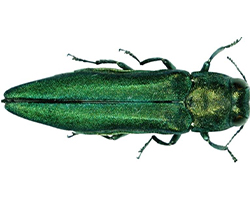
Adult EAB Photo by Pennsylvania Department of Conservation and Natural Resources – Forestry Archive te University
BISMARCK, N.D. (ND Dept. of Ag) – Governor Doug Burgum has proclaimed May 24-30, 2022, as Emerald Ash Borer Awareness Week in North Dakota.
Native to Asia, the emerald ash borer (EAB) attacks true ash trees (Fraxinus spp.). The larvae feed under the bark, disrupting the movement of water and nutrients and killing the tree within several years. EAB has killed hundreds of millions of ash trees in the United States over the past decade.
“EAB is found in 35 states and 5 Canadian provinces, including our neighbors, Minnesota, South Dakota and Manitoba” said Agriculture Commissioner Doug Goehring. “The nearest find, a mere 130 miles from Fargo, was in Sauk Centre, MN. Given the traffic between our states and Canada, it is more important than ever for North Dakotans to take action to prevent it from coming here.”
North Dakota has more than 90 million ash trees. Based on tree inventories in more than 100 North Dakota communities, ash trees make up between 20 percent to 80 percent of trees along streets and in city parks. They are also found in rural plantings and native forest areas.
“EAB spreads slowly on its own, but it can be moved long distances in firewood and ash nursery stock,” State Forester Tom Claeys said. “Please buy your firewood from local sources, and if you are coming from out of the state, please don’t bring firewood with you.”
The North Dakota Department of Agriculture (NDDA), North Dakota Forest Service (NDFS) and NDSU Extension have been working together on emerald ash borer outreach, education and training since 2008. The NDDA, NDFS and city foresters will be placing surveillance traps around the state in the next couple weeks. Nearly 230 EAB traps will be placed in cities, state parks, recreation areas, campgrounds, rest stops and other areas of high risk to survey for EAB.
The two-foot-long, three-sided, purple traps are baited with a lure attractive to emerald ash borers. The traps will be monitored through the summer during the adult flight period.
Goehring and Claeys asked that people encountering one of these traps to please leave it undisturbed.
More information about EAB is available on the NDDA website at www.nd.gov/ndda or www.ndinvasives.org.
